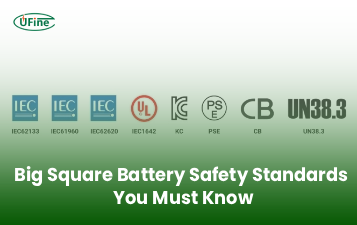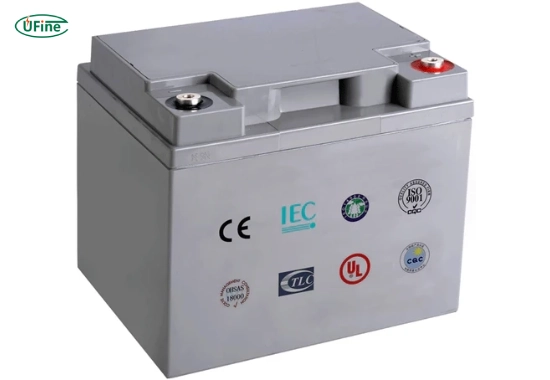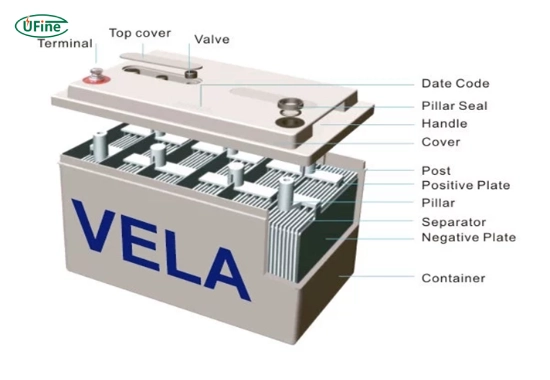
- Part 1. What is a commercial battery?
- Part 2. What is a lithium battery?
- Part 3. What is a lead-acid battery?
- Part 4. What is a VRLA battery?
- Part 5. Battery lifespan comparison: lithium vs. lead-acid vs. VRLA
- Part 6. Energy efficiency comparison: lithium vs. lead-acid vs. VRLA
- Part 7. Safety and risk profile: lithium vs. lead-acid vs. VRLA
- Part 8. Maintenance requirements comparison: lithium vs. lead-acid vs. VRLA
- Part 9. Cold weather performance comparison: lithium vs. lead-acid vs. VRLA
- Part 10. Cost of ownership comparison: lithium vs. lead-acid vs. VRLA
- Part 11. FAQs about commercial battery
Which commercial battery is best: lithium, lead-acid, or VRLA? This is a critical question for any business investing in reliable energy storage. Whether running a data center, a warehouse, an industrial plant, or a solar farm, choosing the correct commercial battery can significantly impact cost, energy efficiency, and long-term performance.
This guide will provide an in-depth comparison of lithium-ion, lead-acid, and VRLA (Valve Regulated Lead Acid) batteries. We’ll explore their technical specs, real-world performance, costs, safety, and maintenance. We aim to help you make an informed decision that fits your operational needs and budget.
Part 1. What is a commercial battery?
A commercial battery is a high-capacity rechargeable energy storage solution used in businesses, industry, and extensive infrastructure. These batteries are designed to:
- Provide backup power during outages
- Support off-grid solar or wind energy systems
- Run UPS (Uninterruptible Power Supply) systems
- Power industrial machinery and telecom towers
Unlike consumer-grade batteries, commercial batteries are engineered for high durability, extended cycles, and larger energy output.
Part 2. What is a lithium battery?
Lithium-ion batteries use lithium metal or lithium compounds as electrodes. They are known for:
- High energy density
- Fast charging
- Long cycle life
- Lightweight design
They are widely used in electric vehicles (EVs), solar energy storage systems, telecom towers, and mission-critical infrastructure.
Technical Specifications of Lithium-ion Batteries
| Specification | Value |
|---|---|
| Nominal Voltage | 48V, 72V, 96V or higher |
| Energy Density | 150–250 Wh/kg |
| Cycle Life | 3000–7000+ cycles (80% DOD) |
| Depth of Discharge (DOD) | Up to 100% |
| Round-trip Efficiency | 92%–98% |
| Operating Temp Range | -20°C to 60°C |
| Maintenance | None (intelligent BMS included) |
| Average Cost/kWh | $400–$700 |
| Weight | Light (depending on capacity) |
Part 3. What is a lead-acid battery?
Lead-acid batteries are among the oldest battery technologies but remain widely used due to their low cost and simplicity.
They consist of lead plates submerged in sulfuric acid. These batteries are commonly used in UPS systems, forklifts, off-grid installations, and emergency backup systems.
Technical Specifications of Lead-Acid Batteries
| Specification | Value |
|---|---|
| Nominal Voltage | 12V, 24V, 48V |
| Energy Density | 30–50 Wh/kg |
| Cycle Life | 500–1000 cycles (50% DOD) |
| Depth of Discharge (DOD) | 50% recommended |
| Round-trip Efficiency | 70%–85% |
| Operating Temp Range | 0°C to 50°C |
| Maintenance | High (water refilling, cleaning) |
| Average Cost/kWh | $100–$200 |
| Weight | Heavy |
Part 4. What is a VRLA battery?
VRLA (Valve-Regulated Lead-Acid) batteries are a sealed version of lead-acid batteries. They are designed to reduce maintenance and are safer for indoor use. VRLA comes in two types:
- AGM (Absorbent Glass Mat) – designed for high-current loads
- GEL – better for deep cycle and high-temperature environments
Technical Specifications of VRLA Batteries
| Specification | Value |
|---|---|
| Nominal Voltage | 12V, 24V, 48V |
| Energy Density | 40–70 Wh/kg |
| Cycle Life | 400–1200 cycles (50% DOD) |
| Depth of Discharge (DOD) | 50%–60% |
| Round-trip Efficiency | 75%–85% |
| Operating Temp Range | -10°C to 55°C |
| Maintenance | None (sealed) |
| Average Cost/kWh | $150–$300 |
| Weight | Heavy |
Part 5. Battery lifespan comparison: lithium vs. lead-acid vs. VRLA
One of the most important factors in battery selection is how long it will last. Here’s a direct comparison of the average lifespan under typical commercial usage conditions.
| Battery Type | Average Lifespan (Years) | Typical Cycle Life | DOD Used | Real-World Use Case Example |
|---|---|---|---|---|
| Lithium-ion | 10–15 years | 5000+ | 90% | Solar + storage for office buildings |
| VRLA (AGM/Gel) | 4–7 years | 600–900 | 50% | UPS systems, telecom towers |
| Lead-acid | 3–5 years | 500–700 | 50% | Backup power for small industrial machines |
Lithium batteries last the longest, especially when cycled daily.
Part 6. Energy efficiency comparison: lithium vs. lead-acid vs. VRLA
Energy efficiency directly affects your electricity costs. Higher efficiency means less energy wasted during charging and discharging.
| Battery Type | Average Round-trip Efficiency | Energy Loss (%) |
|---|---|---|
| Lithium-ion | 92%–98% | 2%–8% |
| VRLA | 75%–85% | 15%–25% |
| Lead-acid | 70%–80% | 20%–30% |
Over time, a 10–20% efficiency loss can mean thousands of dollars in wasted energy.
Part 7. Safety and risk profile: lithium vs. lead-acid vs. VRLA
Safety is essential in commercial battery applications, especially in enclosed or high-traffic environments.
| Battery Type | Overheat Risk | Fire Risk | Emissions | Spill Risk | Indoor Safe? |
|---|---|---|---|---|---|
| Lithium-ion | Medium* | Low–Medium | None | None | Yes (with BMS) |
| VRLA | Low | Very Low | Minimal | None | Yes |
| Lead-acid | High | Medium | Gases | Yes | No (vented) |
*Lithium batteries must include a Battery Management System (BMS) to prevent overcharging or overheating.
Part 8. Maintenance requirements comparison: lithium vs. lead-acid vs. VRLA
Maintenance affects labor costs and system reliability. Here’s how much effort each battery type needs.
| Battery Type | Watering | Cleaning | Scheduled Checks | Replacement Parts |
|---|---|---|---|---|
| Lithium-ion | None | No | Annual | Rare |
| VRLA | None | No | Annual | Rare |
| Lead-acid | Monthly | Yes | Monthly | Frequent |
Lithium and VRLA batteries are ideal for businesses that want “install-and-forget” solutions.
Part 9. Cold weather performance comparison: lithium vs. lead-acid vs. VRLA
Battery performance can drop significantly if your operation is in a cold climate. Here are real-world results:
| Battery Type | Cold Temp Performance (<0°C) | Needs Heating System | Efficiency at -10°C |
|---|---|---|---|
| Lithium-ion | Reduced (30–50%) | Yes (optional BMS) | 70%–80% |
| VRLA | Moderate capacity loss | Not required | 60%–75% |
| Lead-acid | High capacity loss | Not suitable | 50%–60% |
For extreme cold, heated lithium systems are the best option.
Part 10. Cost of ownership comparison: lithium vs. lead-acid vs. VRLA
A lower upfront cost does not always mean a cheaper system in the long run. Let’s compare the Total Cost of Ownership (TCO) over 10 years.
| Battery Type | Upfront Cost ($/kWh) | Lifespan (Years) | Total Replacements | TCO over 10 years ($/kWh) |
|---|---|---|---|---|
| Lithium-ion | $500 | 10–15 | 0 | ~$500 |
| VRLA | $200 | 5–6 | 1–2 | ~$400 |
| Lead-acid | $150 | 3–5 | 2–3 | ~$450–$600 |
Though lithium batteries cost more upfront, they often save money over time.
Part 11. FAQs about commercial battery
What is the safest commercial battery for indoor use?
VRLA batteries are the safest for indoor use. They are sealed, do not emit harmful gases, and require no ventilation.
Can I use lithium batteries in an existing lead-acid setup?
Yes, but you must ensure the system supports lithium. Proper charge controllers and BMS are required to avoid damage.
Which battery is best for solar energy storage?
Lithium-ion batteries are ideal for solar due to their deep discharge capability, long cycle life, and high efficiency.
How often should lead-acid batteries be maintained?
Lead-acid batteries need monthly maintenance, including checking water levels, cleaning terminals, and testing voltage.
What’s the most cost-effective battery for short-term use?
VRLA batteries offer a good balance of safety, performance, and cost for short-term or low-budget projects.
Related Tags:
More Articles

Big Square Battery Safety Standards You Must Know
Learn key safety standards for big square batteries to avoid fire risks, shipping delays, and compliance issues in EV, industrial, and energy storage projects.
Big Square Battery Applications in Solar & Industrial Equipment
Big square batteries deliver high capacity, stable output, and long life for solar, industrial, and backup power. Explore key uses and advantages.
Big Square Battery vs Cylindrical Battery: Complete 2025 Guide for EVs, ESS & Industrial Devices
Choosing the right battery is key for designers and engineers. Compare big square vs cylindrical batteries to find the best fit for your application.
How to Choose the Right Big Square Battery for Your Device?
If you’re choosing a big square battery for EVs, solar, or mobility devices, this guide helps you pick the right solution for real-world needs.
Big Square Battery Complete Guide: Types, Uses & Buying Tips
If you are choosing a big square lithium battery for EVs, solar, RVs, or AGVs, this guide helps you select the right NMC, LFP, or LTO solution with examples.





